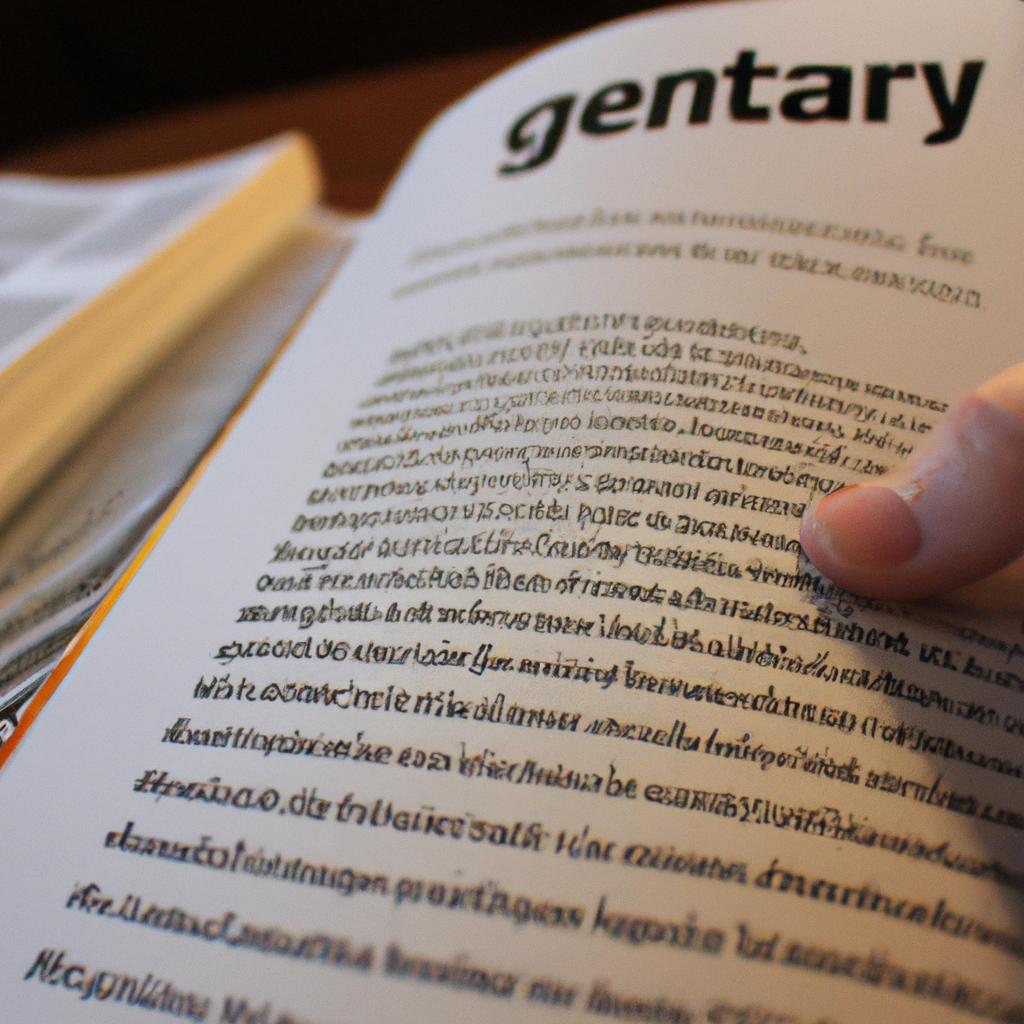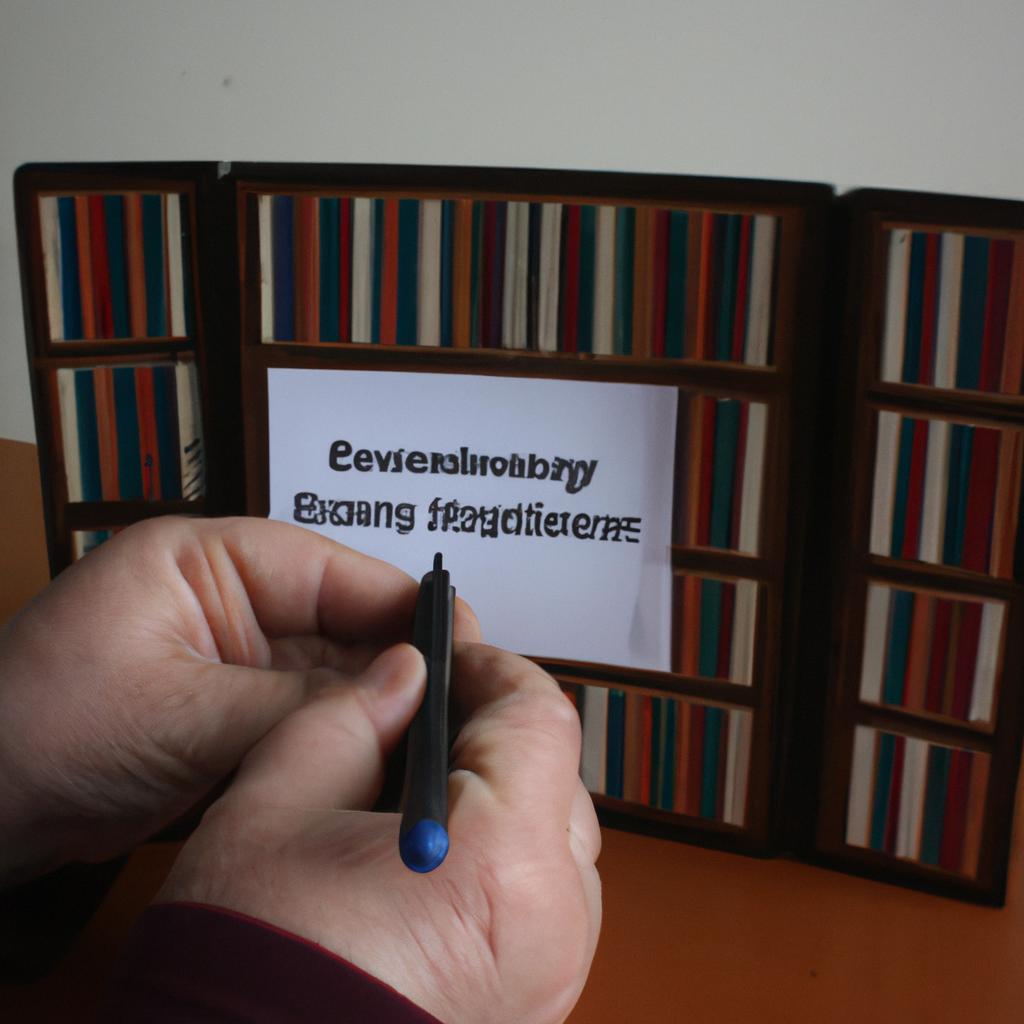The field of genealogy education is an essential aspect of preserving and understanding one’s family history. It involves the study and analysis of various sources to gather evidence that supports or refutes ancestral connections, dates, and other vital information. This article explores the significance of evidence evaluation in genealogy education, highlighting its role in ensuring accuracy and reliability.
Consider a hypothetical scenario where a researcher seeks to trace their lineage back several generations but encounters conflicting information from different sources. Without proper evidence evaluation, they may inadvertently include inaccurate data in their family tree. Hence, it becomes crucial for individuals involved in genealogical research to develop robust skills in assessing the credibility and relevance of various sources at hand. By critically examining primary documents such as birth certificates, census records, wills, and land deeds, researchers can identify inconsistencies, errors, or biases that might hinder accurate conclusions about familial relationships.
Understanding Primary Sources in Genealogy Research
Genealogical research relies heavily on the evaluation of primary sources to uncover accurate and reliable information about our ancestors. These sources, which include official records such as birth certificates, census data, and marriage licenses, provide direct evidence from the time period being studied. Let us consider an example to illustrate the importance of understanding primary sources.
Suppose we are researching a family tree and come across a birth certificate for John Smith dated 1850. At first glance, this seems like a valuable piece of evidence. However, upon closer examination, we discover that it was filed by John’s son many years after his death. This raises questions about its accuracy and reliability. By critically evaluating this primary source and considering additional supporting documents or testimonies, we can determine whether it provides trustworthy information or if further investigation is necessary.
When analyzing primary sources in genealogical research, there are key factors to consider:
- Provenance: Determine the origin and chain of custody of the document to establish its authenticity.
- Context: Examine the historical context surrounding the creation of the source to understand its significance accurately.
- Bias: Recognize any potential biases or limitations within the document that may affect its reliability.
- Corroboration: Seek corroborating evidence from other primary or secondary sources to validate conclusions drawn from a particular document.
| Factors | Importance |
|---|---|
| Provenance | Establishes authenticity |
| Context | Provides historical significance |
| Bias | Identifies potential limitations |
| Corroboration | Validates findings |
By adhering to these principles when assessing primary sources, researchers can ensure greater accuracy in their findings. In doing so, they avoid relying solely on one document but instead create a more robust foundation for constructing their ancestral narrative.
Transitioning into exploring secondary sources for genealogical evidence, it becomes evident that while primary sources play a crucial role in establishing facts about our ancestors, they are not the only sources to consider. Secondary sources provide valuable insights and interpretations of primary materials that can further enrich our understanding of family histories.
Exploring Secondary Sources for Genealogical Evidence
Genealogy research relies heavily on the evaluation of sources to determine their reliability and accuracy. Understanding how to assess primary and secondary sources is crucial in ensuring the integrity of genealogical findings. In this section, we will explore key principles for evaluating evidence in genealogy education, using examples and providing practical guidance.
Consider a hypothetical scenario where an individual seeks to trace their family lineage back several generations. They come across a handwritten diary purportedly belonging to their great-great-grandfather, containing detailed accounts of family history. Although excited by this discovery, they must critically evaluate the diary’s credibility before accepting it as reliable evidence.
To effectively evaluate sources in genealogy research, consider the following:
- Provenance: Examine the origin and ownership history of the source. Determine if there are any gaps or inconsistencies that may raise doubts about its authenticity.
- Contextual information: Assess whether the source provides sufficient context regarding events, individuals, dates, and locations. Lack of contextual details can undermine its reliability.
- External corroboration: Seek additional supporting evidence from other independent sources such as birth certificates, census records, or official documents. Multiple corroborating sources increase confidence in the accuracy of information.
- Expert opinions: Consult with experienced genealogists or historians who have expertise in evaluating similar sources. Their insights can provide valuable perspectives on assessing the reliability of a particular document.
Table Example:
| Source | Provenance | Contextual Information | External Corroboration |
|---|---|---|---|
| Handwritten Diary | Unknown; Passed down through generations | Detailed family history; Names, dates mentioned | Birth certificates confirm names; Census records match some details |
By applying these evaluative criteria to our hypothetical case study’s diary source example, we can make informed decisions about its veracity. Remembering that not all sources are created equal ensures accurate genealogical research and ultimately leads to more reliable family histories.
Moving forward, we will delve into the significance of census records in genealogy education. Understanding how to access, analyze, and interpret these valuable resources is essential for uncovering ancestral connections and building comprehensive family trees.
The Importance of Census Records in Genealogy Education
Sources: Genealogy Education: Evidence Evaluation
In the quest to uncover our ancestral roots, genealogists often rely on a variety of sources to gather evidence. While primary sources are considered the most reliable and direct accounts, secondary sources also play a crucial role in expanding our understanding of family history. These sources can provide valuable context and corroborating information that enhance the accuracy and depth of our research.
For instance, let us consider a hypothetical case where an individual is tracing their lineage back to colonial America. They come across a secondary source—a published local history book—that mentions an ancestor with a unique surname settling in a particular town during that time period. Although this book is not a firsthand account, it can serve as an initial clue or lead to further investigate through other records such as vital records, land deeds, or court documents.
When utilizing secondary sources for genealogical purposes, it is essential to evaluate their reliability carefully. To assist researchers in assessing the credibility of these sources, we present the following guidelines:
- Consider the author’s qualifications and expertise in genealogy.
- Evaluate whether the source is based on thorough research and utilizes multiple references.
- Assess if there are any biases or agendas that might influence the content presented.
- Verify facts and statements by cross-referencing against primary sources whenever possible.
By adhering to these principles, genealogists can make informed judgments about the validity and usefulness of secondary sources within their research endeavors.
Amongst various resources available to genealogists, census records stand out as invaluable tools for reconstructing family histories. Conducted periodically by governments worldwide, these population surveys offer detailed snapshots into people’s lives—providing names, ages, relationships, occupations, immigration details, and much more. Such comprehensive data makes census records indispensable for both novices and seasoned researchers alike.
To illustrate the significance of census records, let us consider a real-life example. In one study, an individual was struggling to determine their great-grandfather’s birthplace due to limited family knowledge. However, upon examining multiple census records spanning several decades, they discovered consistent information indicating that he resided in the same county throughout his life. This led them to explore local vital records and ultimately uncover the elusive birth certificate.
To highlight the advantages of incorporating census records into genealogical pursuits, we present the following table:
| Benefits of Census Records |
|---|
| 1. Enumeration of entire households |
| 2. Tracking individuals over time |
| 3. Identifying neighbors and extended family members |
| 4. Supplementing missing or incomplete primary sources |
With these benefits in mind, genealogists should prioritize exploring census records as part of their research methodology—a practice that can yield significant breakthroughs in unraveling ancestral stories.
Building on our exploration of secondary sources and emphasizing the importance of solid evidence evaluation, we now turn our attention to another invaluable resource—church records—as a valuable genealogical asset.
Using Church Records as a Valuable Genealogical Resource
Sources: Genealogy Education: Evidence Evaluation
Section 3: Evaluating Online Sources for Genealogical Research
In the digital age, online sources have become increasingly important in genealogical research. However, it is crucial to approach these sources with caution and skepticism. One example that highlights the need for careful evaluation of online sources is a case study involving a researcher who mistakenly incorporated incorrect information into their family tree due to reliance on an unreliable website.
To ensure accurate and reliable findings, genealogists must employ evidence evaluation techniques when utilizing online sources. Here are some key considerations to keep in mind:
- Source Reliability:
- Evaluate the credibility of the website or database hosting the source.
- Look for reputable organizations or academic institutions associated with the site.
- Consider whether there is transparency regarding the source’s origins and how it was created.
- Assess if there are clear mechanisms for users to report inaccuracies or provide feedback.
- Information Quality:
- Examine the content itself by cross-referencing with other reliable sources.
- Check for consistency and coherence within the information provided.
- Pay attention to any conflicting or contradictory details that may raise red flags.
- Be wary of sites that lack proper citations or references.
- User Reviews/Feedback:
- Seek out user reviews or testimonials about the website or database.
- Pay attention to any recurring issues mentioned by multiple users.
- Look for positive indicators such as high ratings, recommendations, or endorsements from trusted individuals or organizations.
- Updates and Maintenance:
- Consider whether the source is regularly updated and maintained.
- Outdated information can lead to errors in your research, so prioritize up-to-date sources.
- Check if there are clear indications of when updates were last made.
Table: Pros and Cons of Online Genealogy Sources
| Pros | Cons |
|---|---|
| Convenient access | Potential misinformation |
| Wide range of resources | Lack of quality control |
| Collaboration opportunities | Limited availability |
| Real-time updates | Difficulty in verifying sources |
By employing these evaluation techniques and utilizing reliable online sources, genealogists can enhance the accuracy and validity of their research findings.
Understanding how our ancestors were involved in various military engagements can provide invaluable insights into their lives. Uncovering Military Records for Genealogy Research allows us to delve deeper into their experiences and shed light on previously unknown aspects of our family history.
Uncovering Military Records for Genealogy Research
Sources: Genealogy Education: Evidence Evaluation
Using Church Records as a Valuable Genealogical Resource has provided us with insights into one type of record commonly used in genealogy research. Now, let’s explore another important source that can uncover fascinating details about our ancestors: military records. To illustrate the significance of these records, consider the case of John Thompson.
John Thompson was born in 1820 and served in the Union Army during the American Civil War. By examining his military records, we can gain valuable information about his service, such as his enlistment date, unit assignment, battles participated in, and even any injuries sustained on the battlefield. These details not only provide a deeper understanding of John’s life but also shed light on the broader historical context in which he lived.
When delving into military records for genealogy research, here are some key points to keep in mind:
- Military records often contain personal information beyond just service details. They may include birthdates, hometowns, physical descriptions, marital status, and next of kin.
- Different conflicts have different types of available records. For example, while pension files are abundant for soldiers from the Civil War era onwards, they might be more limited or non-existent for earlier periods.
- It is essential to cross-reference multiple sources when using military records. This helps ensure accuracy and provides a more comprehensive picture of an individual’s military service.
- Don’t forget about auxiliary organizations like veterans’ associations or women’s relief societies; their archives can hold additional information related to your ancestor’s involvement or experiences during wartime.
By utilizing these strategies and considering various aspects of military record analysis, researchers can unlock vital clues towards constructing a detailed family history narrative.
Incorporating DNA Testing in Genealogy Education allows us to dig even deeper into ancestral connections by harnessing the power of genetics. But before exploring this exciting field further, let’s first understand how to effectively evaluate evidence gathered from various sources.
Incorporating DNA Testing in Genealogy Education
Sources: Genealogy Education: Evidence Evaluation
Uncovering Military Records for Genealogy Research has provided valuable insights into the use of military records in genealogical research. Now, let us delve deeper into another crucial aspect of genealogy education – incorporating DNA testing.
Imagine a scenario where an individual is adopted and lacks knowledge about their biological family history. Traditional genealogical research may hit roadblocks due to limited documentation or lack of information. However, by integrating DNA testing into genealogy education, individuals can unlock hidden connections and discover their genetic roots.
To understand the significance of incorporating DNA testing in genealogy education, consider the following benefits:
-
Breakthrough Discoveries: DNA testing allows individuals to connect with distant relatives who share common ancestors but might be unaware of one another’s existence. This can lead to unexpected discoveries, such as finding siblings or uncovering previously unknown branches on the family tree.
-
Validation and Accuracy: While traditional methods rely heavily on historical records and oral histories that may contain errors or omissions, DNA testing provides concrete evidence regarding ancestral relationships. It helps validate existing research findings and enhances accuracy in building comprehensive family trees.
-
Cultural Heritage Exploration: By analyzing DNA results from various regions around the world, individuals gain insight into their ethnic origins and cultural heritage. This fosters a sense of belonging and connection to ancestral traditions, enriching personal identity and fostering appreciation for diverse cultures.
-
Medical Insights: In addition to unraveling ancestry, DNA testing also offers health-related benefits through identification of potential genetic predispositions to certain diseases or conditions. Armed with this knowledge, individuals can make informed decisions about preventive measures or seek appropriate medical advice when necessary.
Incorporating DNA testing into genealogy education opens up exciting new avenues for understanding our pasts while embracing modern scientific advancements. As we continue exploring ways to enhance genealogical research techniques, it becomes increasingly clear that utilizing both traditional methods and emerging technologies can lead to a more comprehensive understanding of our ancestral heritage. By embracing DNA testing, individuals can embark on transformative journeys of self-discovery and forge connections that transcend time.
| Benefit | Description |
|---|---|
| Breakthrough Discoveries | Connect with distant relatives, find siblings, uncover unknown branches |
| Validation and Accuracy | Concrete evidence for ancestral relationships, validates existing research findings |
| Cultural Heritage Exploration | Insight into ethnic origins and cultural heritage, fosters sense of belonging |
| Medical Insights | Identification of potential genetic predispositions to diseases or conditions |
Incorporating DNA testing in genealogy education provides invaluable insights into personal identity, family history, and the human journey through generations. As we embrace this technological advancement alongside traditional methods, we empower ourselves with a deeper understanding of our pasts while preserving our rich heritage for future generations.





